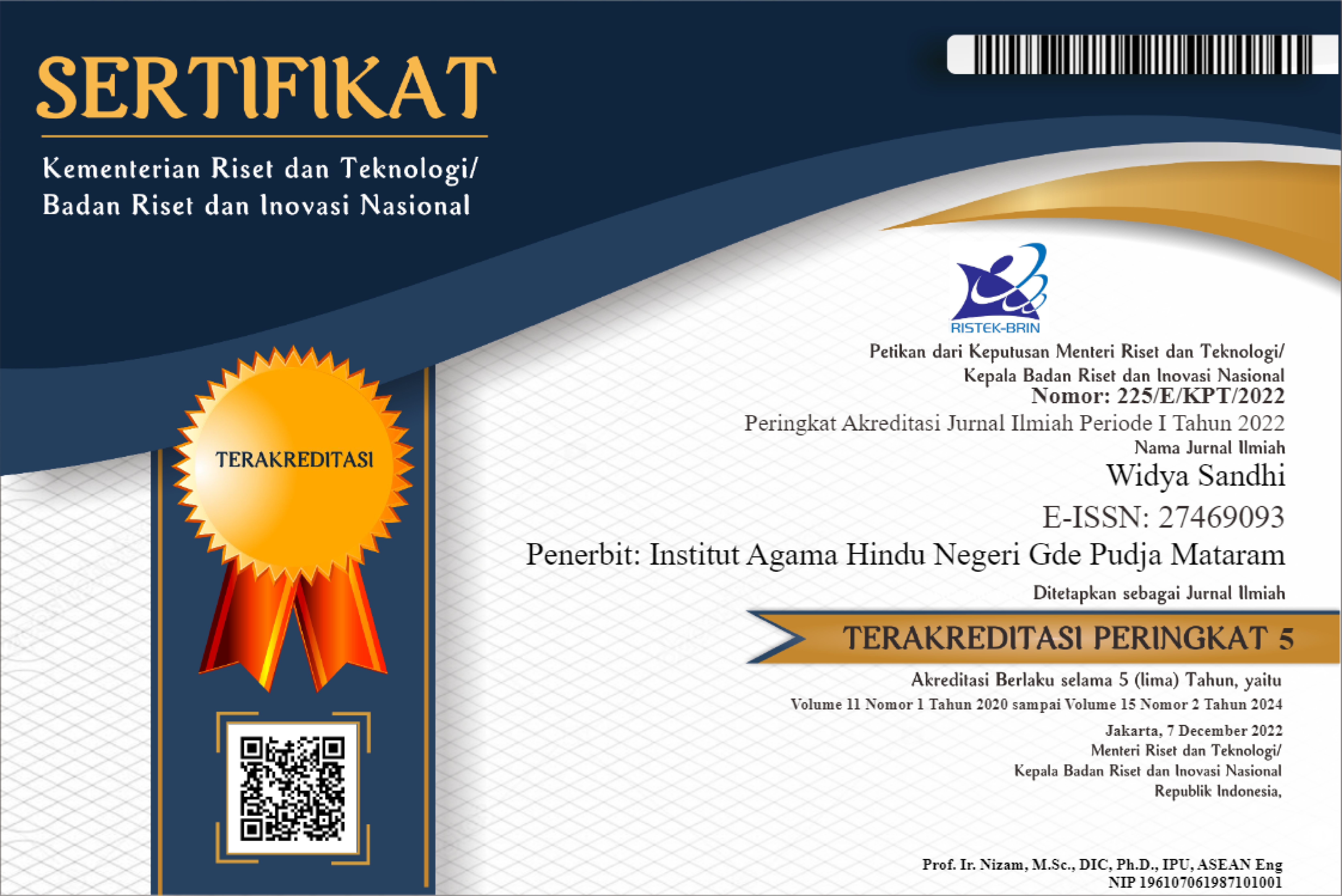Peran Dan Kedudukan Dewa Dalam Teks Bhagawadgita
Abstract
The Bhagavad Gita is one of the most important sacred texts of Hinduism. It contains profound spiritual teachings, including about the role and status of gods. The difference in the concept of gods in the Vedas and the Bhagavad Gita can be traced back to the difference in the concept of God in the two scriptures. In the Vedas, God is depicted as a transcendent being, who is outside the universe. Whereas in the Bhagavad Gita, God is depicted as an immanent being, who is present within the universe. In the Bhagavad Gita, gods are depicted as powerful and compassionate beings. They are the creators, preservers, and destroyers of the universe. Gods also play a role as spiritual teachers who guide humanity towards enlightenment. This article discusses the role and status of gods in the Bhagavad Gita. It discusses how gods are depicted in the text, and how they play a role in human life. The article aims to discuss the concept of gods in the Vedas, and to find explanations about gods, their role and status in the Bhagavad Gita. Based on the study, the concept of gods in the Vedas is different from the Bhagavad Gita. In the Vedas, gods are often equated with God, whereas in the Bhagavad Gita, gods are different from God. This difference is seen in the 39 verses of the Bhagavad Gita that deal with the role, status, and nature of the gods. This shows that the Bhagavad Gita teaches not only about the role and status of gods, but also about the nature of God itself.
References
Debroy, B. (2001). Bhagavata Purana. Surabaya: Paramita.
Hart A. V. P & Satyarajadas. (1989). East West Dialog. New York: Steven Rosen.
Hiriyana, M. ( 1993). Outline of Indian Philosophy. Delhi: Motilal Banarsidass.
Hughes, A. M. (2005). Five Voices Five Faiths. An Interfaith Primer. Massachusetts: Cowley Publications.
Knapp, S. (2001). The Secret Teaching of the Vedas. . New York : World Relief Network.
Krishnananda, S. (1994). A short history of religious and philosophic thought in India. Himalaya: The Divine Life Society.
Ngurah, I. G. (1993). Pendidikan Agama Hindu untuk Perguruan Tinggi. Surabaya: Paramitha.
Palmer, R. E. (2005). Hermeneutika. Teori Baru Mengenai Interpretasi. Yogyakarta: Pustaka Pelajar.
Pandit, B. (2006). Pemikiran Hindu. Surabaya: Paramita.
Pudja, I. G. (1999). Bhagavadgita (Pancama Veda). Surabaya: Paramita.
Rosen, S. J. (2002). The Hidden Glory of India. Cina: Bhaktivedanta Book Trust International.
Sarmah, J. (1978). Philosophy of Education In the Upanisads. India: Gauhaty University.
Satsvarupa. (1996). Elements Of Vedic Thought and Cultures. New York: Gita Press.
Sivananda, S. (1997). Intisari Ajaran Hindu. Surabaya: Penerbit Paramita.
Sudharta, T. R. (1993). Manusia Hindu dari Kandungan sampai Perkawinan. Denpasar: Yayasan Dharma Naradha .
Suryanto. (2006). Hindu di Balik Tuduhan dan Prasangka. Yogyakarta: Narayana Smerti Press.
Tim Penterjemah. (1984). Kembali Lagi. Ilmu Pengetahuan tentang Reikarnasi. Jakarta: Pustaka Bhaktivedanta.
Titib, I. Made. (1996). Pengantar Weda untuk Program D II. Jakarta: Hanoman Sakti.
Titib, I. Made. (1998). Veda Sabda Suci Pedoman Praktis Kehidupan. Surabaya: Paramita.
Wiana, I. K. (1995). Yadnya dan Bhakti dari Sudut Pandang Hindu. Jakarta: Pustaka Manikgeni.
Wiana, I. K. (1989). Bagaimana Umat Hindu Menghayati Tuhan? Jakarta: Pustaka Manik Geni.
Wiana, I. K (2007). Tri Hita Karana. Surabaya: Paramita.

This work is licensed under a Creative Commons Attribution-NonCommercial-ShareAlike 4.0 International License.
Authors who publish with this journal agree to the following terms:
- Authors retain copyright and grant the journal right of first publication with the work simultaneously licensed under a Creative Commons Attribution-ShareAlike 4.0 International License. that allows others to share the work with an acknowledgment of the work's authorship and initial publication in this journal.
- Authors are able to enter into separate, additional contractual arrangements for the non-exclusive distribution of the journal's published version of the work (e.g., post it to an institutional repository or publish it in a book), with an acknowledgment of its initial publication in this journal.
- Authors are permitted and encouraged to post their work online (e.g., in institutional repositories or on their website) prior to and during the submission process, as it can lead to productive exchanges, as well as earlier and greater citation of published work (See The Effect of Open Access).






.jpg)




